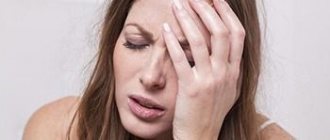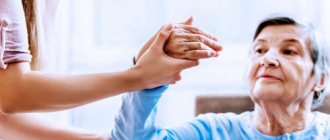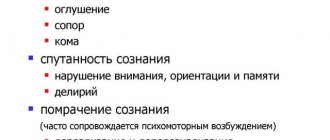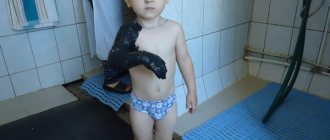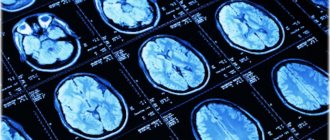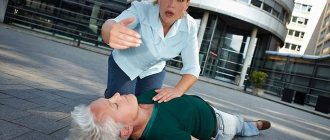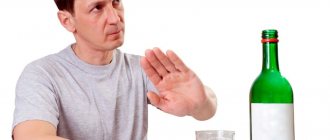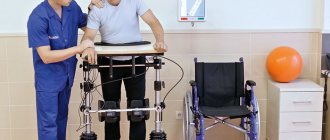Muscle pain after a stroke, which should be treated immediately, occurs in most patients. Muscle soreness can interfere with the body's recovery. Post-stroke pain can be strategic or thalamic. Strategic pain occurs in the area of the brain that controls sensations, particularly pain, and is caused by spasms. Thalamic pain appears after a stroke in one side of the body several months after the circulatory disorder. Neurologists at the Yusupov Hospital, together with rehabilitation specialists, help patients overcome pain and continue to restore lost functions. Patients are treated using modern equipment and innovative techniques to achieve maximum results.
Causes of muscle pain during stroke
In order to begin treatment after a stroke, it is necessary to understand the cause of muscle pain. After a violation of the blood circulation in the brain, hardening of the muscles is often observed; in the absence of rehabilitation measures, they become rigid.
In the human body, some muscles are designed to bend the legs and arms, while others are responsible for straightening the limbs. Normally there is a balance between them. During a stroke, areas of the brain that send nerve impulses to the limbs are damaged, causing some muscles to dominate over others. This imbalance is called contracture, and when it occurs, pain and spasms are observed in the muscles.
Swelling: causes and solutions
Some patients have swelling in their paralyzed leg after a stroke. This phenomenon is explained by the fact that this disease negatively affects both hemispheres of the brain, disrupting the functioning of all body systems. The genitourinary system and kidneys are no exception. Violation of their proper functioning leads to additional problems in the form of:
- seizures,
- swelling,
- involuntary urination,
- disturbances of water and electrolyte balance in the body.
The paralyzed leg swells immediately after the attack. Unilateral swelling can also be caused by thrombosis of the deep veins of the leg. If the patient does not receive the necessary medications in a timely manner, the stroke may recur.
Only a specialist can determine the cause of swelling and determine ways to eliminate it. Therefore, you should not try to solve this problem yourself. If it occurs, it is strongly recommended to immediately contact your doctor or make an appointment at the stroke clinic closest to the patient’s place of residence and strictly follow the recommendations received there.
Muscle pain after a stroke: treatment
You should not self-medicate for pain in the limbs after a stroke; in this case, you need to consult a neurologist. The doctor is able to accurately determine the causes, taking into account the characteristics of the body, and prescribe comprehensive treatment for post-stroke pain. At the moment pain appears, it is necessary to understand where it is localized and after what actions it appears. Neurologists and rehabilitation specialists recommend that patients monitor their sensations and also record the moments when pain occurs.
In order to begin restoring motor function and pain in the legs after a stroke, you need to contact a neurology clinic and also make an appointment with a rehabilitation specialist. If you do not begin to treat this problem, the muscles may harden and the limbs will not be able to straighten, which will aggravate the condition and slow down the recovery of the body. Treatment of pain syndrome is carried out using physiotherapy, medication, and securing the limbs in a normal position using splints.
Additionally, to relieve spasms and restore motor function, neurologists prescribe physical therapy, laser therapy, magnetic therapy, massage and heat treatment to patients. Pain in the legs after a stroke, the treatment of which is successful with specially selected exercise therapy exercises, can hinder the patient’s recovery.
Traditional methods for relieving pain after a stroke are based on rubbing the limbs with oils; these procedures allow you to restore sensitivity. There is also a known recipe for a special ointment for rubbing, consisting of alcohol and vegetable oil in a ratio of 1:2. Baths made from a decoction of rosehip roots, pine needles, and celandine are effective in solving the problem. Before using these methods, it is important to consult your doctor and determine the presence of contraindications.
Home care for patients after a stroke
No matter how severe the stroke may be, with proper treatment and the patient’s active participation in rehabilitation procedures, most of the body’s functions are restored.
The patient needs a full range of procedures for rehabilitation, including therapeutic exercises and massage.
Turn a bedridden patient every two hours to prevent the formation of bedsores. Properly position the patient's paralyzed arm and leg:
In the supine position:
1. To prevent the development of stiffness in the shoulder joint and the appearance of pain in it:
- Place a stool next to the bed, on the paralyzed side, and place a large pillow on it so that the corner of the pillow is under the patient’s shoulder joint.
- Extend your client's arm at the elbow. Place it palm up, straighten your fingers, apply a splint and bandage it to your arm. The longueta should reach the middle of the forearm.
- Move the patient's arm to the side 90° (maintaining a palm-up position) and place it on a pillow so that the shoulder joint and the entire arm are at the same level horizontally.
- Place a roller between your arm and chest so as to fix your arm in the correct position; if necessary, place a 0.5 kg bag of sand on the roller.
2. Bend the patient’s paralyzed leg at the knee 15-20°. Place a cushion under your knee.
3. Place your foot in the middle position between flexion and extension and secure it with a stand.
In the “healthy side” position:
- Bend the patient’s paralyzed arm at the shoulder and elbow joints and place a pillow under it;
- bend the paralyzed leg at the hip, knee and ankle joints and place a pillow under it.
In the “lying on the paralyzed side” position:
- tilt the patient's head down slightly;
- Stretch the patient’s paralyzed arm forward at a right angle to the body and turn it palm up;
- place the patient’s healthy arm to one side or move it back (but not forward!);
- slightly bend the patient’s paralyzed leg at the knee joint, but straighten it at the hip;
- Bend your healthy leg at the hip and knee joints and place a pillow under it.
To maintain mobility of the joints in the paralyzed arm and leg, perform “passive exercises” with the patient: first take the patient’s hand and carefully make certain movements, and then make movements with the patient’s paralyzed leg.
Perform a set of therapeutic exercises with your ward every 4 hours.
Make sure that the movements are smooth and do not cause pain.
Make sure that the patient does breathing exercises. Breathing affects muscle tone.
Keep in mind that the behavior of patients with right-sided paralysis differs from the behavior of patients with left-sided paralysis.
| RIGHT-SIDED violation paralysis of the LEFT side of the body |
| Underestimating the scale of movement disorders, the patient is indifferent to his situation |
Characteristic
|
What to pay attention to:
|
| LEFT SIDE disorder paralysis of the RIGHT side of the body |
| Lethargy, passivity. loss of difficult emotional experiences |
Characteristic
|
What to pay attention to:
|
Restoring motor activity after a stroke.
Exiting bed rest should be done gradually and only in consultation with a doctor.
First, they teach the patient to sit down, then do exercises for the legs, then stand up, and only then walk.
If the person in your care cannot sit up independently:
1. Help him sit up first.
2. Then he needs to learn to sit in bed.
3. Provide the bed with special devices so that the patient can sit up without your help.
4. Teach the patient to lower his legs from the bed and transfer to a nearby chair or wheelchair.
5. Gradually teach the patient:
1) stand;
2) transfer the weight of the body from one side of the body to the other;
3) take steps on the spot;
4) to learn to walk, purchase a walker.
6. When teaching walking, stay close to the patient on the affected side..
Helping patients eat after a stroke.
The physician should assess the patient's ability to swallow and chew and prescribe an appropriate diet.
It is easier for a patient with impaired chewing and swallowing functions to swallow soft food than liquid food.
If you are drooling from the paralyzed side of your mouth, make sure your face is dry and clean. Lubricate the skin near your mouth with a protective cream.
Always serve food to your client from the side, on the uninjured side, and place it on the side of the mouth that is not affected.
After eating, make sure that there is no food left in the patient's mouth.
Monitoring the patient.
Watch your skin and take all measures to prevent bedsores.
Such patients often have urinary and fecal incontinence; take proper care of the patient.
To restore a normal sleep cycle:
- lower the air temperature in the patient’s room at night;
- reduce the calorie content of food and its temperature (after a hot, hearty meal a person falls asleep);
- Organize your ward’s daytime so that he has something to do all the time.
Call a doctor if
- There was an increase in temperature and severe pain in the side. Bedridden patients have a high risk of pneumonia;
- swelling has appeared on the paralyzed side - this may be a sign of vein thrombosis.
Provide your client with emotional support. Reassure him that his family loves and appreciates him regardless of his condition.
Therapist (head) of the day care department Lyudmila Vyacheslavovna Narab
Prevention of muscle pain after stroke
The occurrence of pain after a stroke can be associated with various factors. Neurologists and rehabilitation specialists advise patients to follow recommendations that will prevent the onset of this condition. Measures to prevent muscle pain after a stroke:
- do not take hot baths;
- prefer clothes made from natural materials, do not wear light clothes;
- be in a comfortable position and avoid tightly grouping the body;
- do not put pressure on the affected side;
- use special devices for paralyzed and weakened limbs;
- fix the paralyzed arm while sitting so that the pain localized in the shoulder does not get worse;
- When moving, support from another person is desirable.
If you have pain in the legs after a stroke, it is important to trust treatment to qualified neurologists and rehabilitation specialists. Experienced doctors work at the Yusupov Hospital, which is located in Moscow on Nagornaya Street, and they will select methods for treating post-stroke pain depending on the mechanism of manifestation. Timely consultation with a doctor is the key to the patient’s recovery. You can make an appointment with a doctor and get answers to your questions about stroke treatment and rehabilitation by phone.
Types of pain, causes of their occurrence
Pain in the arms and legs can occur either immediately after a stroke or after several weeks. In some cases, it begins to appear even after several months of the rehabilitation period. Pain in the arms and legs after a stroke is divided into two types: local and central.
The cause of local pain syndrome is problems with joints and muscles. It is caused by damage to the peripheral nervous system, has a relatively low intensity, and does not have a significant effect on the patient’s lifestyle.
Central pain occurs due to damage to the brain. He begins to misinterpret the signals coming from the body and mistakes even the lightest touch on the skin for pain impulses. The pain may:
- be of a paroxysmal or continuous nature,
- manifest as tingling or burning sensation,
- change intensity due to temperature changes, etc.
Intense pain prevents the patient from performing even basic self-care tasks.
Often the cause of pain in an arm or leg paralyzed after a stroke is contracture. It occurs when, as a result of an attack, the muscles of the limbs responsible for their flexion begin to dominate over those that control extension.
When you try to bend or straighten an arm or leg, a muscle spasm occurs, which manifests itself in the form of severe pain. If muscle spasms are not treated immediately after a stroke, the paralyzed limb may become rigid in a bent position and cannot be straightened.
